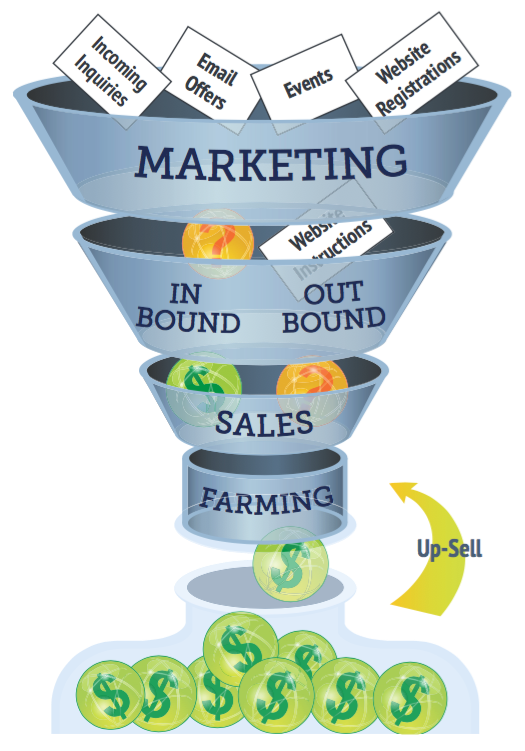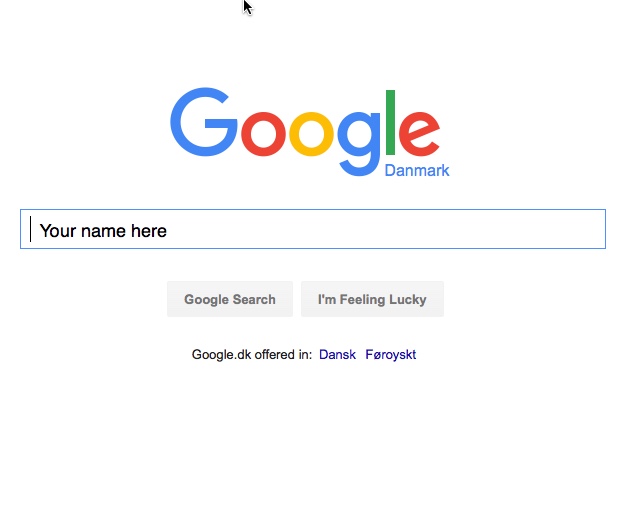Social Selling Without Situational and Contextual Content Is like Partying with Robots – Part 3
 This series of posts is about the relationship between marketing/sales communication and revenue generation. It is inspired by the sales messages that I receive regularly pushing products and services notoriously without any insight into or interest for my business or my current situation. Receiving such messages and calls is like being at a party with robots. They look human, but they are unable to ask situational questions, listen, analyze or provide a contextual response, so all they do is replay programmed propaganda messages irrespective of what you ask or tell them. It is a party with a lot of noise, but it is awfully boring and never leaves a good, lasting impression.
This series of posts is about the relationship between marketing/sales communication and revenue generation. It is inspired by the sales messages that I receive regularly pushing products and services notoriously without any insight into or interest for my business or my current situation. Receiving such messages and calls is like being at a party with robots. They look human, but they are unable to ask situational questions, listen, analyze or provide a contextual response, so all they do is replay programmed propaganda messages irrespective of what you ask or tell them. It is a party with a lot of noise, but it is awfully boring and never leaves a good, lasting impression.
Sales
Let me jump to the stage in the funnel where we engage with named individuals. I call this the sales stage and it can initially be divided into two main categories:
- They contact you (inbound leads)
- You contact them (outbound leads)
Inbound leads
 All my business comes from inbound leads, but I realize that not all sales people are that fortunate. Getting inbound leads is great as you can ask questions to understand where they are on the buyer’s journey and how they should be served moving forward. Some are very early in the buying stage and need more contextual need/pain related content to better understand their own situation, some need propaganda to understand what you have to offer and some need situational content to meet their specific requirements (e.g. a phone call, a meeting, a demonstration or a proposal).
All my business comes from inbound leads, but I realize that not all sales people are that fortunate. Getting inbound leads is great as you can ask questions to understand where they are on the buyer’s journey and how they should be served moving forward. Some are very early in the buying stage and need more contextual need/pain related content to better understand their own situation, some need propaganda to understand what you have to offer and some need situational content to meet their specific requirements (e.g. a phone call, a meeting, a demonstration or a proposal).
Outbound leads
There are many companies (most?) that do not get enough inbound leads to satisfy their need for revenue growth. They need sales development people to contact[1] potential customers, and this is where things go wrong. Getting in touch with individual potential customers to test and then activate their needs requires a number of steps.
Going back to Kierkegaard in post #2 your approach should always be to learn and help, but how early can you engage and how much can you afford to invest in one-on-one situational conversations?
When I was a salesman selling business management solutions to the newspaper industry I personally facilitated the entire customer journey and took care of all contacts with the buying personas myself. My company invested in trade shows and conferences such as WAN/IFRA (Europe) and NEXPO (North America) where the buying personas came to us, but otherwise it was I who made contact with them and organized personal appointments. The purchase processes were extremely complex and correspondingly very long, the switching cost was enormous and the average project had double-digit million-dollar price tags.
Investing heavily in building relationships with all the potential customers in most corners of the world made sense because the market was global and there were only a limited number of purchase projects open in any year. If we were not considered as a potential vendor before the project went into the RFP-stage[1] then we had no chance of winning the business. The deals were front-loaded providing cash up front and payments tied to milestones and final delivery. After successful implementation we could charge for maintenance, support and add-on functionality.
A market with few but very high priced deals requires that you continuously build individual relationships and nurture these for years preparing for the day where the customer enters the active project stage. The price tags and payment format justifies the investment in sales resources and activities.
A market with many deals and small price tags calls for a different approach relying more on one-to-many marketing activities and automated nurturing. When the delivery format is associated with payments related to consumption of the solution, then recouping the sales cost becomes a huge challenge and you need to enter the individual sales stage either shortly before closing time or in a format that is less costly to maintain.
Social selling
 So how can you use social media as a low cost engagement activity in your selling efforts and what are the guidelines for doing it effectively?
So how can you use social media as a low cost engagement activity in your selling efforts and what are the guidelines for doing it effectively?
Work on your profiles first
It starts with your own social media profiles. There is no reason to drive potential customers to your profiles if you leave them confused and offer no value.
Do your social media profiles clearly convey your value proposition for your key target audience? Is it clear for any visitor what insight and domain competencies that you possess and offer? Is it clear that you could be a valuable resource to have in the visitor’s network?
Your social media profile is a piece of propaganda, but you should use it to convey domain insight and skills that are important to your potential customers rather than to your potential employers[2].
Turn up the volume
Are your social media profiles dead?
A Twitter account with no tweets and no followers? A LinkedIn profile with no updates and activities related to your profession? A Facebook profile showing you in a funny costume and drunk at a stag party? You claim that you are a professional or maybe even a thought leader, but you don’t show it.
How can you be a trusted capacity for your potential customers, when you never share anything professional on social media?
The best you can do is produce your own content showing your insight and experience with the challenges and opportunities that your customers are facing. The next best is sharing quality content produced by others, but still closely related to the challenges and opportunities that your customers are facing.
Making connections
 Now you can start making connections and with the content that you produce or share on a regular basis you can now become a potential valuable source of domain insight relevant to your target audience.
Now you can start making connections and with the content that you produce or share on a regular basis you can now become a potential valuable source of domain insight relevant to your target audience.
You can easily answer the question: Why should I connect with you? – “Because I work with the same challenges and opportunities as you do and I post professional content on social media that may be of value to you”.
This is the nucleus of the sales discipline where you are always offering something with a higher value than what you expect in return.
As opposed to the traditional approach: “Hey, I want to connect because I have something that I want to sell to you,” which I can confirm isn’t perceived well by most people.
Make yourself familiar with the plumbing
 Focus on the social media platforms that are most widely used by your target audience and then learn how the plumbing works. You must know about hashtags, DMs and retweets if you use Twitter. You must understand the fundamentals[3] of LinkedIn if this is where you engage with your audience. There are books, webinars, whitepapers and blog posts on how to use any social media platform. Google what you need and get familiar with the fundamentals.
Focus on the social media platforms that are most widely used by your target audience and then learn how the plumbing works. You must know about hashtags, DMs and retweets if you use Twitter. You must understand the fundamentals[3] of LinkedIn if this is where you engage with your audience. There are books, webinars, whitepapers and blog posts on how to use any social media platform. Google what you need and get familiar with the fundamentals.
Keep up the volume
As a sales person you need to manage your pipeline and be selective as to where you invest your resources. Regular posting of professional material and making comments to other’s postings are required to maintain your presence and visibility with your target audience.
As potential customers move into buying mode you need to monitor their social media behavior to see what they are currently busy with and you need to respond correspondingly with situational and contextual content.
Not everyone is active on social media
 Bear in mind that many of your key connections are not active on and do not visit the social media platforms on a regular basis. The rule of thumb is that the higher in the organization they sit the less they post and the less often they visit the social media platforms, but social media activity is in general very individual.
Bear in mind that many of your key connections are not active on and do not visit the social media platforms on a regular basis. The rule of thumb is that the higher in the organization they sit the less they post and the less often they visit the social media platforms, but social media activity is in general very individual.
Maybe your potential market is so big that you don’t need to worry about the portion not active on social media, but if that is not the case then you may have to engage with them and push information to them through other more conventional channels.
Also remember that not everyone enjoys reading. Some prefer videos and others podcasts that they consume while waiting, driving or flying. Repackage your content so you reach a much larger portion of your key audience.
Search
 Whatever you post on social media is indexed by the search engines. As you build your repository of posts and engage in the online activities the probability that you will be found by people searching for what you do will increase.
Whatever you post on social media is indexed by the search engines. As you build your repository of posts and engage in the online activities the probability that you will be found by people searching for what you do will increase.
You should definitely pay attention to the key words and phrases used in your industry and make sure your content includes those that are relevant.
Each sales person cannot be a search engine optimization expert, but you need to be familiar with the basics and you should expect that the assets provided by your marketing department are optimized for the search engines.
This is actually much easier than it sounds because you cannot engage effectively in the discussions of your customers’ challenges and opportunities unless you speak their language.
Social selling may not be the holy grail
Even though most of my own business comes though social media I cannot recommend that you rely entirely on these channels unless you have carefully done your homework first.
How, how much and for what you should use social media in your sales effort comes down to an individual assessment of your business model, your business model environment, your revenue generation process and the skills of your revenue generation organization. All of which must be designed to facilitate your customers’ buying journeys.
If social media can and should play an important role in facilitating your customers’ purchase processes, then you shouldn’t leave the initiative to each individual sales person (and just give her a ½-day introduction to LinkedIn), but treat the area as a strategic component of your marketing mix. Define how you recommend using social media in your specific situation, provide a repository of assets and templates to be used and find out how to benchmark the best performing approaches[4].
Expecting each sales representative to generate their own content is utopian. Those who can will do it and you don’t want those who cannot to even try. Leaving the initiative to the individual sales person may make some successful, but it will be impossible to scale predictably.
Download this series of posts as a whitepaper.
–ooOoo–
[1] Contact can be made in many ways such as meeting them at a conference, sending a Tweet, calling on the phone, sending an email, sending an InMail or inviting to connect on LinkedIn.
[2] I will even argue that your next employer may recognize this as an important skill and differentiator to other candidates.
[3] Believe me, most sales people do not understand the fundamentals of LinkedIn.
[4] See Trish Bertuzzi, The Sales Development Playbook: Build Repeatable Pipeline and Accelerate Growth with Inside Sales. Moore-Lake; 1 edition (January 15, 2016)
Download this series of posts as a white paper.


 The vast majority of sales people have social media profiles designed to get another job and not another customer.
The vast majority of sales people have social media profiles designed to get another job and not another customer.






